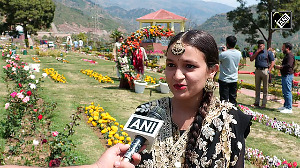Indian flag flies high at the brand new international atom smasher experimental facility near Geneva in Switzerland, which became operational on Wednesday.
A Wednesday. Will the world survive it?
India has made major scientific and technological contribution to this new atom smasher also called the Large Hadron Collider. LHC is expected to answer several facts of fundamental nature of the universe that remains a mystery, said the scientists of Tata Institute of Fundamental Research.
TIFR will webcast Wednesday's event in Geneva through its bandwidth, for the benefit of media as well as the scientists, Prof Atul Gurtu, senior scientist, department of high energy physics, TIFR said.
Indian laboratories, led by Raja Ramanna Centre for Advanced Technology (RRCAT) at Indore, have contributed substantially towards construction of the accelerator (LHC) itself, with many components being fabricated by Indian industry and supplied to CERN, Gurtu said.
These had to satisfy not only exacting standards of precision but also follow a stringent time-line as dictated by the CERN schedule.
Towards the scientific side, two Indian teams are participating in different experiments.
Each of these collaborations is huge with 1000-2000 scientists from 125-150 top class institutions from 20-30 countries participating in it.
Each full detector costs around $400-500 million to build and the R&D and fabrication takes around a decade.
Prof Raghav Verma of Indian Institute of Technology, Mumbai, representing Indian scientists, has carried an Indian flag, IIT sources said.
LHC has been constructed at the European Laboratory of Particle Physics (CERN) located a few kilometers outside Geneva.
Conceptualized around a quarter century back, approved for construction in the mid-1990s and now almost a decade in the making, this technological marvel of a machine which accelerates counter rotating beams of protons in two steel pipes 27 kilometers in circumference is ready to operate.
It will become the highest energy particle accelerator in the world with 7 times as much energy punch compared to the existing accelerator at Fermilab, USA.
Asked the role of Indian scientists, Gurtu said they have been active in this field and had collaborations with their counterparts at CERN and Fermilab.
However, it is for the first time that a concerted, coordinated and comprehensive contribution made by India towards such a huge international scientific program, he said.
One Indian team participates in the CMS experiment with TIFR as the nodal institution and includes scientists from BARC, Delhi, Punjab and Vishwa Bharati universities.
The other team is in the ALICE experiment with VECC/SINP (Kolkata) as the nodal institutions and IOP, IITB, Jammu, Rajasthan, Aligarh and Punjab universities.
Gurtu said the scientific goals are truly stupendous, ranging from understanding the microcosm of the sub-nuclear world to attempting to answer the question what was the universe like at the very beginning of time, a few moments after the big bang.





 © 2025
© 2025